I use AdventureWorks2012 and do a test. and my question: Why is SELECT statement directly performance lower than table values function. I only put SELECT statemnt into table value function and Completely opposite performance.
CREATE FUNCTION [dbo].[atest1]
(
@iBusinessEntityID INT
)
RETURNS @t TABLE
(
[BusinessEntityID] INT
, [NationalIDNumber] NVARCHAR(15)
, [JobTitle] NVARCHAR(50)
)
AS
BEGIN
INSERT INTO @t
SELECT
[e].[BusinessEntityID]
, [e].[NationalIDNumber]
, [e].[JobTitle]
FROM [HumanResources].[Employee] [e]
INNER JOIN [Person].[Person] [p]
ON [p].[BusinessEntityID] = [e].[BusinessEntityID]
WHERE [e].[BusinessEntityID] = @iBusinessEntityID;
RETURN;
END;
--TEST PERFORMANCE
SELECT
*
FROM [dbo].[atest1](5);
GO
SELECT
[e].[BusinessEntityID]
, [e].[NationalIDNumber]
, [e].[JobTitle]
FROM [HumanResources].[Employee] [e]
INNER JOIN [Person].[Person] [p]
ON [p].[BusinessEntityID] = [e].[BusinessEntityID]
WHERE [e].[BusinessEntityID] = 5;
